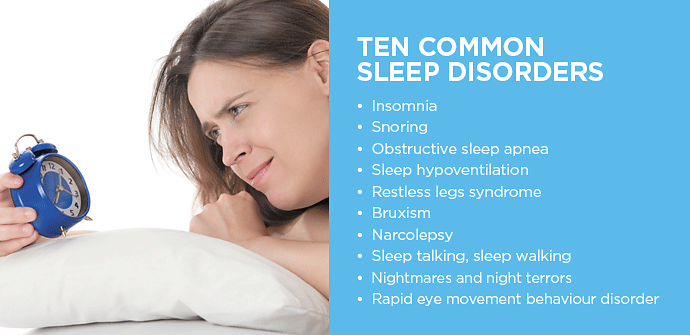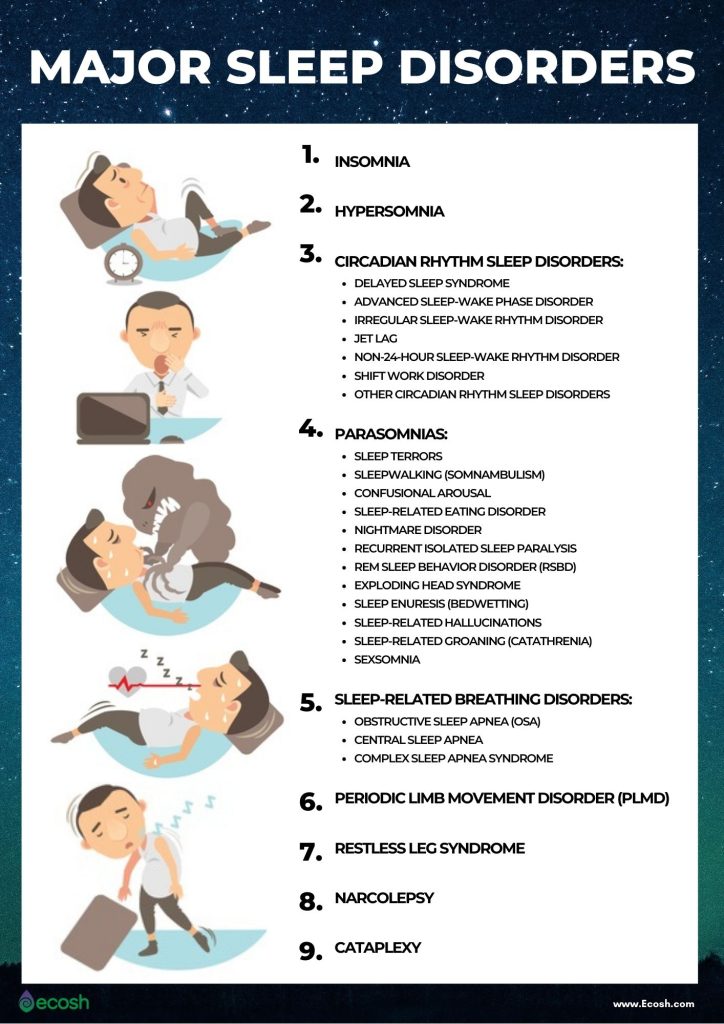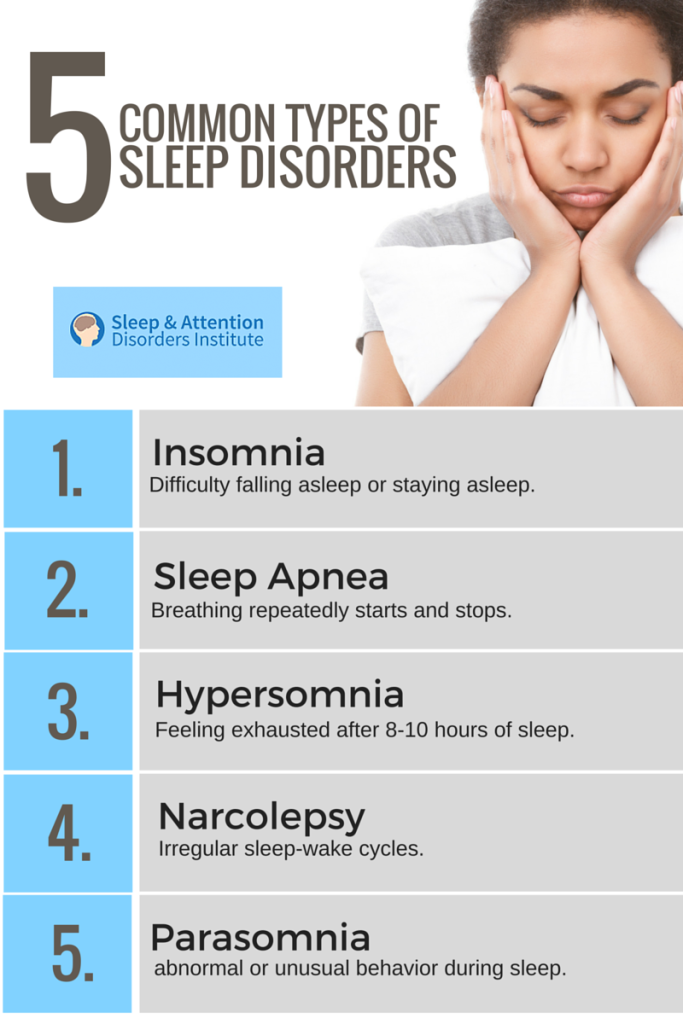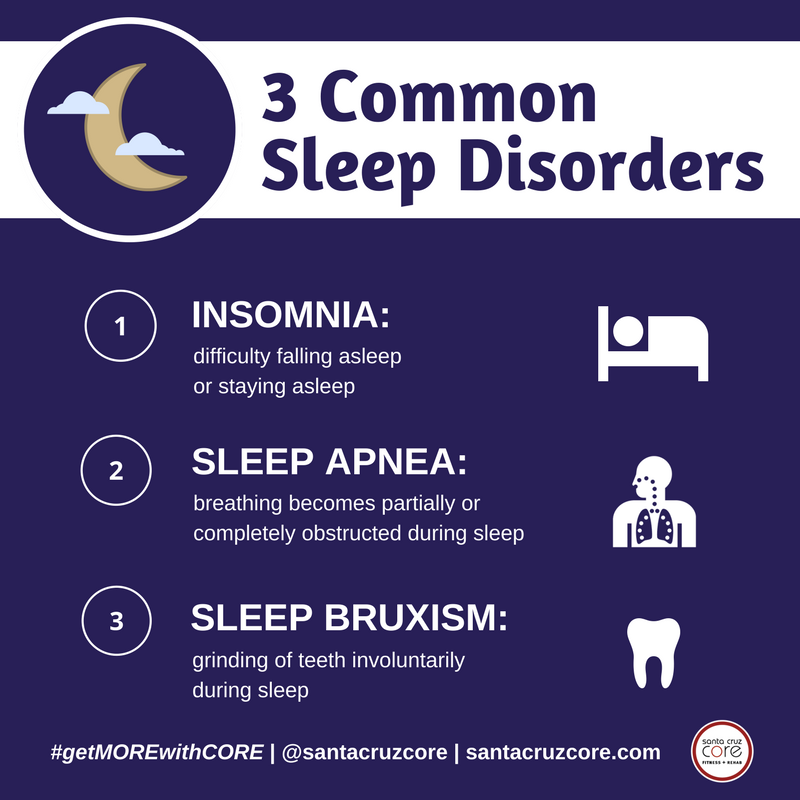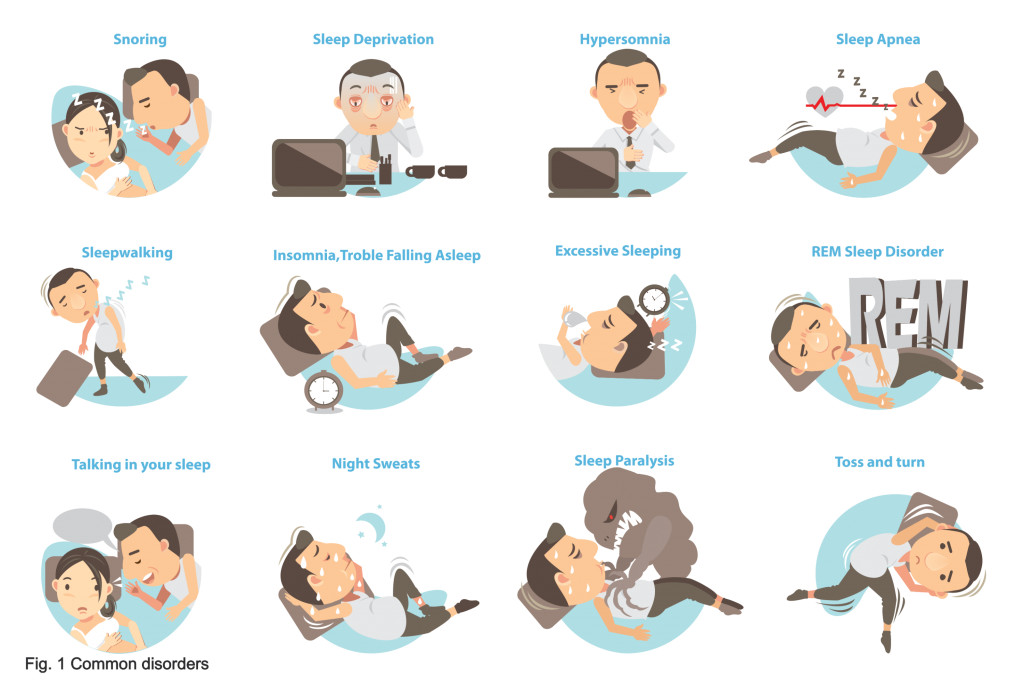It’s no secret that a good night’s sleep is essential for our overall well-being.
However, what happens when various disorders disrupt our sleep?
This article will explore some of the most common sleep disorders many individuals face.
From insomnia to sleep apnea, we will delve into the symptoms, causes, and potential treatments for these conditions, providing you with valuable insights to help promote better sleep.
So, if you’ve ever wondered what may be keeping you up at night, get ready to uncover the answers and find solutions for a more restful slumber.
Review contents
Insomnia
Primary Insomnia
One of the most well-known and prevalent sleep disorders is insomnia. Insomnia is characterized by difficulty falling or staying asleep, which results in inadequate rest. Primary insomnia refers to insomnia that is not caused by any underlying medical condition or substance use. It is often caused by psychological factors such as stress, anxiety, or depression. Individuals with primary insomnia may experience restless nights and find themselves tossing and turning in bed.
Secondary Insomnia
Secondary insomnia, on the other hand, occurs due to an underlying condition or medication. This type of insomnia is commonly seen in individuals with chronic pain, gastrointestinal disorders, or respiratory diseases. Certain medications like antidepressants, corticosteroids, or stimulants can also cause it. Secondary insomnia can be a temporary condition but can persist if the underlying cause is not addressed.
Maintenance Insomnia
Maintenance insomnia is a type of insomnia where individuals have difficulty staying asleep throughout the night. They may wake up frequently at night and have trouble falling back asleep. This can lead to fatigue and exhaustion during the day, disrupting their sleep cycle.
Onset Insomnia
Onset insomnia is difficulty falling asleep at the beginning of the night. Individuals with onset insomnia may lie awake in bed for hours, unable to initiate sleep. This can be frustrating and lead to increased anxiety about sleep, further exacerbating the problem. Various factors, including stress, anxiety, or poor sleep habits can cause the onset of insomnia.
Comorbid Insomnia
Comorbid insomnia occurs in conjunction with another medical or psychiatric condition. For example, individuals with comorbid insomnia may also have chronic pain, depression, or post-traumatic stress disorder (PTSD). Treating the underlying condition is crucial in addressing comorbid insomnia, as it improves sleep quality and duration.
Sleep Apnea
Sleep apnea is another common disorder affecting a significant portion of the population. It is characterized by pauses in breathing during sleep, which can occur multiple times throughout the night.
There are three main types of sleep apnea: obstructive sleep apnea, central sleep apnea, and complex sleep apnea syndrome.
Obstructive Sleep Apnea
Obstructive sleep apnea (OSA) is the most common type. It occurs when the muscles in the throat and upper airway relax, causing an airway blockage.
This blockage results in pauses in breathing, often followed by loud snoring or choking sounds when the individual resumes breathing. OSA can significantly impact sleep quality and lead to daytime sleepiness and fatigue.
Central Sleep Apnea
Central sleep apnea (CSA) is less common and occurs when the brain fails to send the proper signals to the muscles that control breathing. Unlike OSA, CSA is not caused by a physical obstruction in the airway.
Instead, it is a result of a lack of respiratory effort due to the brain’s inability to regulate breathing during sleep. Individuals with CSA may experience episodes of non-breathing, followed by awakenings or gasping for breath.
Complex Sleep Apnea Syndrome
Complex sleep apnea syndrome (CSAS) is a combination of both obstructive sleep apnea and central sleep apnea.
It is often seen in individuals with pre-existing obstructive sleep apnea who may develop central sleep apnea after initiating continuous positive airway pressure (CPAP) therapy. CSAS requires careful evaluation and treatment to effectively manage both obstructive and central apneas.
Narcolepsy
Narcolepsy is a neurological sleep disorder that affects the brain’s control of sleep-wake cycles. It is characterized by excessive daytime sleepiness, frequent and uncontrollable sleep attacks, and a tendency to enter rapid eye movement (REM) sleep quickly.
Excessive Daytime Sleepiness
Excessive daytime sleepiness (EDS) is the primary symptom of narcolepsy. Individuals with narcolepsy often struggle to stay awake and alert during the day, regardless of how much sleep they got the night before.
This can greatly impact their ability to function and concentrate on daily tasks, leading to impaired performance at work or school.
Cataplexy
Cataplexy is a sudden loss of muscle tone triggered by strong emotions such as laughter, surprise, or anger. During a cataplectic episode, individuals may experience muscle weakness or even complete muscle paralysis. This symptom can be debilitating and affect an individual’s quality of life.
Sleep Paralysis
Sleep paralysis is a temporary inability to move or speak that occurs when falling asleep or waking up.
It can be a frightening experience as individuals may feel fully conscious but unable to move their body. Sleep paralysis is often accompanied by hallucinations, further contributing to fear and confusion.
Hypnagogic Hallucinations
Hypnagogic hallucinations are vivid and often frightening hallucinations that occur when falling asleep or waking up.
These hallucinations can involve sensory perceptions, such as seeing people or objects that are not present or hearing voices or sounds that do not exist. Hypnagogic hallucinations can be extremely vivid and may cause distress or anxiety in individuals experiencing them.
Restless Legs Syndrome (RLS)
Restless Legs Syndrome (RLS) is a neurological disorder characterized by an irresistible urge to move the legs, often accompanied by unpleasant sensations. These sensations typically worsen during rest or inactivity and can significantly disrupt sleep.
Sensations in the Legs
People with RLS often describe uncomfortable sensations in their legs, such as creeping, itching, aching, or burning. These sensations typically occur in the evening or at night and can range from mild to severe. The only relief from these uncomfortable sensations is movement, such as walking or stretching.
Leg Movement Disorder
The urge to move the legs experienced in RLS often leads to repetitive leg movements during sleep, known as periodic limb movement disorder (PLMD). These movements can disrupt sleep and may cause awakenings throughout the night. Both RLS and PLMD can contribute to daytime fatigue and disrupted sleep patterns.
Ekbom Syndrome
Ekbom syndrome, also known as RLS augmentation, is a phenomenon that can occur in individuals being treated with medication for RLS.
After initiating dopaminergic medications, it refers to increased RLS symptoms, such as frequent and intense leg discomfort. Ekbom syndrome often requires adjustments in medication dosage or alternative treatment strategies.
Periodic Limb Movement Disorder
Periodic Limb Movement Disorder (PLMD) is a sleep-related movement disorder, characterized by involuntary leg movements during sleep.
These movements typically involve flexing or extending the legs, which can occur every 20 to 40 seconds. PLMD can disrupt sleep and may lead to excessive daytime sleepiness, as individuals may not be aware of these movements during the night.
Sleepwalking
Sleepwalking, also known as somnambulism, is a behavior disorder that occurs during deep sleep. It involves complex behaviors carried out while an individual is still asleep, usually during the first few hours after falling asleep.
Episodes of Walking
During sleepwalking episodes, individuals can walk around their sleeping environment, seemingly awake but unaware of their actions. Sleepwalkers may perform routine activities or even more complex actions, such as dressing themselves or leaving the house. It is important to ensure a safe sleeping environment for sleepwalkers to prevent any potential accidents or injuries.
Sleep Talking
Sleep talking, or somniloquy is a sleep disorder characterized by talking during sleep. Sleep talkers may speak incoherently or have full conversations while asleep. Sleep talking is relatively common and usually harmless, but it can be disruptive to sleeping partners or family members.
Sleep Terror Disorder
Sleep terror disorder, also known as night terrors or sleep terrors, is a sleep disorder characterized by intense fear or terror during sleep. Sleep terrors typically occur during non-rapid eye movement (NREM) sleep and can involve sudden awakening, screaming, or displaying signs of extreme distress. Sleep terror episodes can last for several minutes but are often not recalled by the individual the next day.
Nightmares
Nightmares are vivid and distressing dreams that often wake individuals up abruptly, causing intense fear or horror. These dreams can be so distressing that they can cause difficulty falling back asleep and may result in waking individuals up in a state of confusion or panic.
Vivid and Distressing Dreams
Nightmares are typically associated with vivid and emotionally charged dreams, often involving threatening or dangerous situations.
The content of nightmares can vary significantly among individuals but commonly includes themes of being chased, attacked, or experiencing a life-threatening event. The emotional impact of nightmares can linger long after waking up, affecting an individual’s mood and well-being.
Nightmare Disorder
Nightmare disorder refers to frequent and recurrent nightmares that significantly disrupt sleep and cause distress or impairment in daily functioning. Individuals with nightmare disorder often experience anxiety or fear about going to sleep due to the anticipation of having nightmares. The treatment for nightmare disorder may involve therapy techniques aimed at reducing anxiety and addressing any underlying issues contributing to the nightmares.
Sleep Talking
Sleep talking, also known as somniloquy, is a sleep disorder characterized by talking during sleep. Sleep talkers may speak incoherently or have full conversations while asleep. Sleep talking is relatively common and usually harmless, but it can be disruptive to sleeping partners or family members.
Somniloquy
Somniloquy, or sleep talking, occurs during different stages of sleep, including both REM and non-REM sleep. The content of sleep talking can range from random utterances to complete conversations that make sense or relate to the dream content. Sleep talking is generally not a cause for concern unless it disrupts sleep quality for the individual or their sleeping partner.
Nocturnal Enuresis
Nocturnal enuresis, commonly known as bedwetting, is a sleep disorder that involves involuntary urination during sleep. It is particularly common in children but can also occur in adults.
Various factors, including developmental delays, urinary system issues, or emotional stress can cause nocturnal enuresis. Bedwetting treatment options may include behavioral interventions, medications, or addressing any underlying medical issues.
Bruxism
Bruxism is a sleep disorder characterized by the excessive grinding or clenching of teeth during sleep. It can be a subconscious habit and may lead to various dental health issues and discomfort.
Teeth Grinding
Teeth grinding, or sleep bruxism, often occurs during REM sleep when the brain is highly active. Individuals with bruxism may unconsciously grind, clench, or gnash their teeth together, leading to tooth wear, jaw pain, headaches, and muscle soreness.
The exact cause of bruxism is not fully understood, but factors such as stress, sleep disorders, or misaligned teeth can contribute to its development.
Temporomandibular Joint Disorder (TMJD)
Bruxism can also contribute to the development of temporomandibular joint disorder (TMJD), which affects the joints that connect the jaw to the skull.
TMJD can cause pain and discomfort in the jaw, face, or ears, and it may interfere with normal jaw movement. Treating bruxism often involves managing stress, using mouthguards to protect the teeth, and addressing any underlying dental or skeletal issues.
Circadian Rhythm Disorders
Circadian rhythm disorders refer to disruptions in the body’s internal biological clock, which regulates sleep-wake cycles. These disorders can lead to difficulties falling asleep at the desired time or staying awake during the day.
Delayed Sleep-Wake Phase Disorder (DSWPD)
Delayed Sleep-Wake Phase Disorder (DSWPD) is a circadian rhythm disorder characterized by a delayed sleep-wake cycle. Individuals with DSWPD may have difficulty falling asleep until very late at night and struggle to wake up in the morning. This delay in their sleep-wake pattern can make it challenging to adhere to typical work or school schedules.
Advanced Sleep-Wake Phase Disorder (ASWPD)
Advanced Sleep-Wake Phase Disorder (ASWPD) is the opposite of DSWPD, where individuals have an earlier sleep-wake cycle.
Individuals with ASWPD tend to feel very sleepy in the early evening and wake up very early in the morning. This can cause difficulty staying awake in the evening and can interfere with social or work commitments that occur later in the day.
Irregular Sleep-Wake Rhythm
Irregular Sleep-Wake Rhythm is a circadian rhythm disorder characterized by fragmented sleep patterns and no clear distinction between sleep and wake periods.
Individuals with irregular sleep-wake rhythm may experience multiple periods of sleep and wakefulness throughout a 24-hour cycle, with no fixed bedtime or wake-up time. This irregular sleep pattern can make it challenging to maintain regular daily activities.
Shift Work Sleep Disorder
Shift Work Sleep Disorder (SWSD) is a circadian rhythm disorder commonly seen in individuals who work outside the typical day-shift hours.
The irregular work schedules can disrupt the body’s natural sleep-wake pattern and make it difficult for individuals to get sufficient sleep. SWSD often results in excessive sleepiness during work hours and difficulty staying awake during the night shift, leading to impaired performance and increased risk of accidents.
Sleep Paralysis
Sleep paralysis occurs when an individual temporarily experiences a loss of muscle control and is unable to move or speak while transitioning between sleep and wakefulness. It can be a frightening and unsettling experience.
Loss of Muscle Control
During sleep paralysis episodes, individuals may be wholly or partially paralyzed, unable to voluntarily move any part of their body.
This loss of muscle control typically lasts for a few seconds to a few minutes and can be accompanied by a sense of pressure on the chest or difficulty breathing. Being aware of one’s surroundings while unable to move can be distressing.
Inability to Move or Speak
The main characteristic of sleep paralysis is the inability to move or speak despite being fully aware of one’s surroundings.
Individuals may try to call for help or move their limbs but cannot. This sensation can be alarming, especially if individuals are unfamiliar with the phenomenon.
Hallucinations
Sleep paralysis episodes often involve hallucinations, which can further contribute to the fear and uneasiness experienced during the episode.
These hallucinations can be auditory, visual, or tactile and may involve seeing shadowy figures, hearing strange noises, or feeling a presence in the room. It is essential to understand that these hallucinations result from the brain transitioning between sleep stages and do not indicate any underlying psychological disorder.
In conclusion, sleep disorders can significantly impact an individual’s overall well-being and quality of life.
They can affect a person’s ability to fall, stay, or experience restful sleep, leading to daytime fatigue, impaired cognitive function, and emotional distress. Understanding the different types of sleep disorders and their associated symptoms is crucial for diagnosis and appropriate treatment.
If you or someone you know is experiencing sleep-related issues, it is highly recommended to consult with a healthcare professional for further evaluation and guidance. Remember, a good night’s sleep is essential for optimal physical and mental health, so take the necessary steps to ensure a restful night’s sleep.


